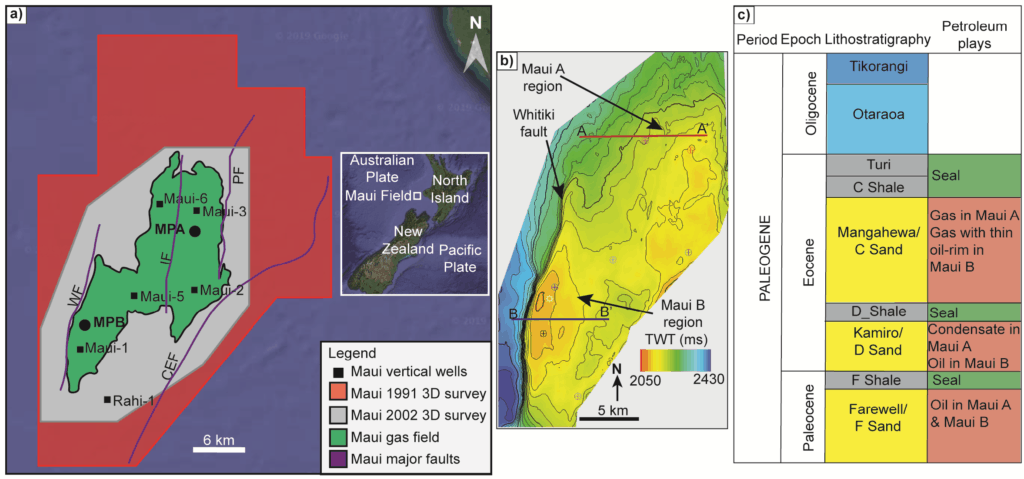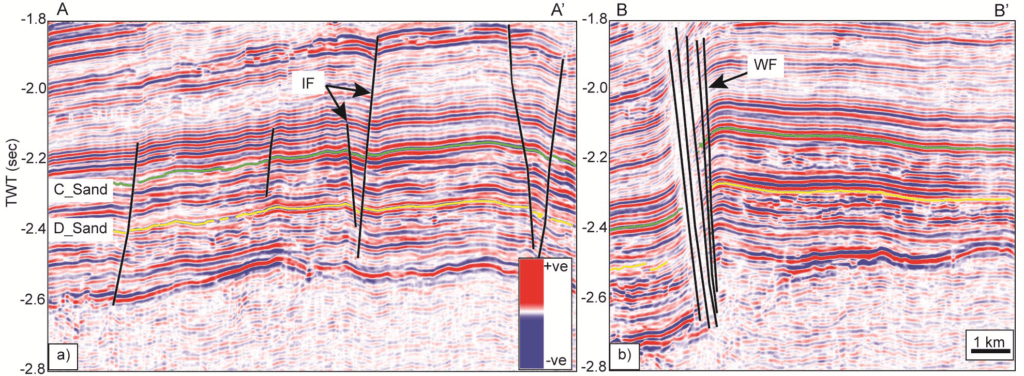Summary
Subtle fault detection plays a vital role in reservoir development analysis because faults may form baffles or conduits that significantly control how a petroleum reservoir is swept. Small throw faults may be overlooked in seismic amplitude data. Seismic attributes aid in mapping small faults, however, over the years, dozens of seismic attributes have been developed to offer additional tempting but challenging features for interpreters. Using the Maui 3D seismic data acquired in the Offshore Taranaki Basin, New Zealand, we generated typical seismic attributes useful for fault detection. We found multiple attribute analyses provided greater geological information than analyzing individual attribute volumes. We extract geological content of multiple simultaneous attributes with principal component analysis (PCA) and an unsupervised machine learning algorithm, Self-Organizing Maps (SOM). From our investigation, incorporating appropriate seismic attributes that exhibit anomalous features at the same seismic voxel with PCA and SOM analyses aided in integrating the geological context, in this case four seismic attributes combined in one classification volume. This classification volume enables us to image subtle faults affecting the C Sand reservoir of Maui Field which are difficult to image by using conventional seismic interpretation techniques.
Introduction
Imaging subtle faults plays a crucial role in reservoir modelling and reservoir characterization analysis. Mapping faults with small throws, which we will call small faults in this paper, aids in understanding the hydrocarbon migration pathways and identifying bypassed oil accumulation within a petroleum reservoir. The conventional fault interpretation techniques are highly demanding (i.e. require more time and experience) and sometimes, challenging for mapping small faults. Over the last few decades, geoscientists have devoted great effort to developing computer-aided fault detection techniques and seismic attributes to help detecting faults. Dozens of geometric attributes such as dip, coherence (Chopra and Marfurt, 2007), curvature (Al-Dossary and Marfurt, 2006) and aberrancy attributes (Qi and Marfurt, 2018) have been developed. Although these attributes accelerated the interpretation of faults, for large projects, analyzing every individual attribute volume becomes a tedious and time-consuming process.
To ease the interpretation process of small faults, we integrate the geological information from multiple seismic attribute volumes by using machine learning clustering techniques such as self- organizing maps. In this paper, we will investigate the different geometric attributes that are sensitive to small faults by using a dataset from Maui field in Offshore Taranaki Basin, New Zealand. We suggest a workflow that enables interpreters to apply principal component analysis (PCA) and self- organizing maps (SOM) on the most appropriate mathematically independent seismic attributes to get one classification volume. Our aim is to obtain one clustered volume that best shows all small faults affecting the area.
Field and Dataset
The Maui field is one of the largest New Zealand gas fields, covers around 1000 km2 and is located 40 km off the West coast of the North Island, New Zealand (Figure 1a). The field consists of two gentle anticlinal features; Maui A region in the northeast and Maui B region in the southwest (Figure 1b). The field produces gas from three main sand reservoirs called Mangahewa/C Sand, Kaimiro/D Sand and Farewell/F Sand formations of the Kapuni group (Figure 1c). The C Sand reservoir, which is the focus of this research, contains a shallower and larger gas column compared to the D Sand, however, it has a very thin oil-rim in the Maui B region (Stephen et al., 2004). Structurally, the field is highly complicated; the Maui A region is bounded to the east by the normal Cape Egmont fault (CEF) and Pungawerewere normal fault (PF) while the Maui B region is bounded to the south-west by the reverse Whitiki fault (WF) (Figure 1a). A seismic line extracted from the seismic volume over the Maui A region shows that the reservoir is mainly affected by normal faults (Figure 2a). Another seismic line crossing the Maui B region shows slightly different structural features (Figure 2b) where this part of the field is highly affected by regional reverse fault WF. This indicates that the northern part of the field is more faulted compared to the southern part of the field.
The dataset used in this research is shown in Figure 1 consists of a 1000 km2 3D prestack depth migrated (PSDM) seismic volume, which is a merged volume of two 3D seismic volumes acquired in 1991 and 2002 with eight vertical wells sets of conventional wells logs. The data were made available for research purposes by the Ministry of Business and Innovation & Employment (MBIE), New Zealand.
Methodology
The seismic data was cropped laterally to cover 410 km2 and vertically to focus on the area of interest between 1.8 and 2.8 s. The data was then resampled from 4 ms to 2 ms. We followed Marfurt’s (2006a) approach and applied a well established principal component structure-oriented filter along structure dip to simultaneously enhance the signal aligned with the estimated dip and also cancel random noise that crosses in other directions. Following this, we calculated most of the geometric attributes available for a seismic interpreter such as volumetric dip, coherence (multispectral and broadband energy ratio similarity), curvature, curvedness and aberrancy attributes. We analyzed individual seismic attributes to select attributes that would work best for PCA and SOM analyses.
Seismic attribute analysis
We investigated most of geometric seismic attributes that aid in detecting faults and will discuss the most useful ones by using horizon extractions along the top of the C Sand reservoir comparing seismic amplitude and various geometric attribute volumes. A seismic amplitude slice (Figure 3a) shows faults with clear offsets such as WF (green arrow) affecting the west side of Maui B and parts of the faults affecting the northern part of the field. However, the result seem very sensitive to noise (purple arrow).
A dip magnitude slice (Figure 3b) shows clear edges that indicate faults within the reservoir (white, orange, black and cyan arrows). The multispectral energy ratio attribute (Figure 3c) shows small faults affecting the northern part of field (white arrow) and Ihi fault (IF; black arrow). The most positive (K1) and most negative (K2) principal curvature attributes are useful for mapping faults, however, K2 attribute shows better lineaments compared to those imaged by K1 (Figures 3d and 3e). The curvedness attribute describes the total deformation of a seismic event and shows lineaments that indicate faults and fractures affecting the reservoir. We observe that the curvature attributes illuminate faults with small offsets below seismic resolution that can’t be imaged by using energy ratio similarity attribute. For instance, curvedness slice shows the conjugate faults of fault IF nicely (Figure 3f) whereas the energy ratio similarity shows only parts of these faults that exhibit clear offset (Figure 3c). However, energy ratio similarity shows the en-echelon set of small faults affecting the northern part of the field nicely while dip and curvature attributes show two continuous interesting faults (Figures 3b and 3e). These faults show clear offset but don’t cause a large deformation (i.e. changes in dip or bending) within the faulted seismic events. The total aberrancy magnitude attribute shows faults and microfracture that aren’t well imaged by other geometric attributes (Figures 3g). Thus, there is no one attribute that can show all the faults and fractures affecting a reservoir because every attribute shows anomalous features based on the deformation occurred within the faulted layers. Therefore, integrating the geological information from multiple seismic attributes by using computer-aided machine learning techniques (e.g. SOM and PCA) into one classification volume would be useful.

Unsupervised machine learning techniques for small fault detection
SOM trains a non-linear neural network to numerous seismic attribute volumes simultaneously to better understand how these attributes relate. It groups similar data and uses a 2D topology map to plot these groups or clusters, thus reduces the dimension of the data (Roden et al., 2015). Selecting the right attributes to use for SOM specifically controls the classification results (Barnes and Laughlin, 2002). PCA is a linear mathematical technique that aids in distilling a big library of seismic attributes into a small set of mathematically independent attributes based on the relative variance of the attributes within the area of interest (Roden et al., 2015). However, PCA doesn’t provide any information about the spatial positions of the anomalous zones within the different seismic attributes. Thus, the appropriate input attributes to PCA and SOM analyses should show anomalous features at the same seismic voxel.
In the proposed workflow, we used four attributes consisting of multispectral energy ratio similarity, dip magnitude, curvedness and total aberrancy magnitude for PCA analysis. The aforementioned weighted attributes based on the relative contribution of each attribute within the interval of interest from the PCA analysis were then fed to SOM analysis to combine the geological context from these attributes into a classification volume of several distinct classifications (Figure 4a). The PCA and SOM analyses were performed on the seismic samples (voxels) within the interval of interest from the C Shale horizon to D Sand horizon. The SOM analysis employed an 8×8 topology.
A horizon slice extracted along top of the C Sand reservoir from the SOM classification volume clearly shows small faults affecting the reservoir (Figure 4b). It shows sharp edge of a NW-SE fault that seemed to be cut by a set of en-echelon NE-SW normal faults (white arrow) that are affecting the northern part of the field. It provides nice and sharp edges for faults affecting Maui east and west (orange arrows) and Maui south (blue arrow). The SOM shows the sharpest image of the conjugate Ihi faults (black arrow), which consist of a small segmented faults that seem to touch each other at the tips of these small faults. Although being small conjugate faults with drags, the sealing of this fault is questionable. After 29 years of production from the C Sand reservoir in the east of IF, the MA-02A well (white circle) penetrated the same reservoir in the west side of IF encountered bypassed gas with the original depth of the gas-water contact, revealing that reservoir was unswept (unpubl. report). We also found SOM useful in mapping small faults that can be easily overlooked by using conventional fault interpretation techniques. For instance, we were able to image small faults affecting the southern part of the field (blue arrow). A recent study published about the structural modeling of Maui field (Haque et al., 2016) using 3D seismic amplitude and variance volumes didn’t clearly reveal these faults.

Conclusions
Subtle faults can be overlooked in seismic amplitude data but in appropriate geologic situations, they can form important seals or conduits that dramatically control how hydrocarbon migrates and trap within a petroleum reservoir. An effective approach to image small faults is to integrate the geological context of different seismic attributes using machine learning algorithms. Using computer-aided PCA and SOM techniques, we were able to image subtle faults affecting the C Sand reservoir of Maui Field, New Zealand that were not easily revealed from conventional seismic interpretation techniques.
Acknowledgments
The authors would like to thank the PL 537 licence partners for permission to publish this paper. We would also like to thank to our colleagues in IPN: Toshiro Tamura, Tone Merete Øksenvåg and Marius Lunde for their contributions. Thanks also are extended to Geophysical Research, LLC (d/b/a Geophysical Insights) for the research and development of the Paradise AI workbench and the machine learning applications used in this paper. Finally, we would like to thank Hal Green for review of the manuscript and Leah Justis for editing the graphics.
References
Al-Dossary, S. and Marfurt, K. J. [2006] 3D volumetric multispectral estimates of reflector curvature and rotation. Geophysics, 5, p. 41-51.
Barnes, A. E. and Laughlin, K. J. [2002] Investigation of methods for unsupervised classification of seismic data. 72nd Annual International Meeting, SEG, Expanded Abstracts, 2221–2224.
Chopra, S. and Marfurt, K. J. [2007a] Seismic attributes for prospect identification and reservoir characterization. SEG Geophysical Developments Series No. 11, 481 pp.
Haque, A. E., Islam, MD. A. and Shalaby M. R. [2016] Structural modeling of the Maui Gas Field, Taranaki basin, New Zealand. ScienceDirect, Petroleum Exploration and Development, 6, 965 – 975. Qi, X. and Marfurt, K. J. [2018] Volumetric aberrancy to map subtle faults and flextures. Interpretation, 2, 349-365.
Roden, R., Smith, T. and Sacrey, D. [2015] Geologic pattern recognition from seismic attributes: Principal component analysis and self-organizing maps. Interpretation, 4, 59-83.
Stephen, P., Slger, S. and Dekker, S. [2004] Constraining complex gas-water dynamic color model using 4D seismic. Annual Technical Conference & Exhibition, SPE, Houston, Texas, USA.






















